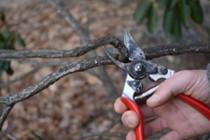To Prune or Not to Prune

We’ve all heard that Fall is for planting, but what about pruning? Generally speaking, Fall is a poor time to prune woody plants. As days shorten and temperatures cool, woody plants are drawing resources from the canopy down into the roots for winter storage to fuel spring growth. Pruning branches can signal the plants to throw new growth, pulling resources in the wrong direction. This new growth will often be tender and prone to frost and cold damage as we head in to winter.
Why Not - Fall is also a time of decay, and the current drought notwithstanding, generally a time when fungal loads are high. Creating wounds on woody plants in fall creates opportunities for fungal diseases to gain a foothold. Bugs are also looking for places to hang for the winter. Cooler weather can slow tissue healing, keeping wounds open and accessible to pests and disease through the fall and into winter.
Late pruning also removes essential nutrient resources from the plant which could be stored in roots over winter for the next growing season. Removing these essential nutrients can impact tree health in the season ahead. Pruning is also a stressor for the tree. In the current drought conditions, when woody plants are already under stress, pruning can severely impact tree resilience and reduce vigor in the season to come.
The 3 D’s - Of course, at any time you can remove the 3 D’s – Dead, Damaged or Diseased tissue. Removing deadwood does not impact the tree as long as you are not cutting into live tissue during the removal. In the case of damaged branches, safety is the chief consideration, with major pruning deferred until the tree is fully dormant. With diseased branches, take care to keep the wound as small as possible, and use good sanitation practices with tools to avoid spreading disease to other parts of the plant. If your lilacs have blight, best to just remove and destroy the affected foliage, and wait ‘til next year to prune.
A better time – Once woody plants are dormant, you can start pruning. With the weather patterns of recent years, that’s likely going to be after the new year. Most people opt for late dormant season, particularly if you have extensive work or major pruning to do. Pathogen loads and insects are low-to -non-existent and sap isn’t flowing so a good time for pruning. Spring bloomers are best pruned after they flower, so they have all summer to feed themselves and put on a great show the next spring.
The beginning of March marks the start of pruning season for New Hampshire gardeners and home orchardists. Check the UNH Extension website for more information on the current Pruning Demonstration schedule Pruning Trees and Shrubs | Extension.
